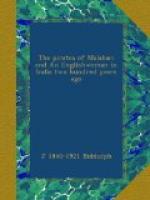At the same time he set to work to build fighting ships. Within a few months of his arrival, the Britannia, eighteen guns, built at Carwar, the Fame, sixteen guns, built at Surat, and the Revenge, sixteen guns, built at Bombay, were flying the Company’s flag. It was easier to build ships than to get sailors to man them, in view of the miserable pay given by the Company, and the attractions of service under native chiefs. Many of the crews were foreigners, who were ready enough to take service with Angria, if the inclination took them, and the bulk of the crews were Indian lascars. A few months later, the Victory, twenty-four guns, was launched, and two years after his arrival, Boone had at his disposal a fine fleet consisting of nineteen frigates, grabs, ketches, gallivats, and rowing galleys, carrying two hundred and twenty guns, besides a bomb vessel and a fireship. With such a force much ought to have been accomplished, but throughout his tenure of office Boone’s efforts were crippled by the incompetency and indiscipline of those on whom he depended to carry out his designs: while the efficiency of the ships was diminished by their employment to carry cargoes along the coast.
In March, 1717, Bombay was stirred by the arrival of a private ship, the Morning Star, which had escaped the Beyt pirates after a long and severe encounter. The affair is described by Hamilton; but he modestly conceals the fact that he was himself in command of the Morning Star, of which he was chief owner. The ship was on its way from Gombroon to Surat, with a valuable cargo, of which the pirates had intelligence; and two squadrons were fitted out to waylay her. On the 20th March she was assailed by eight pirate ships, the largest of which was of five hundred tons, three others being of nearly three hundred tons each, and the rest galleys and shybars, or half-galleys. Between them they carried about two thousand men. On board the Morning Star there were only six Europeans, a number of native merchants, and about thirty-five or forty lascars, about half of whom were trustworthy. The first attack was made by the largest of the pirate ships alone, and was beaten off with loss to the assailants. In the fight, Hamilton had his thigh pierced through with a lance. For the rest of that day and the whole of the following no further attack was made; but the pirates hung around planning another assault. On the 22nd it was delivered. The two largest pirates ran the Morning Star aboard, one on her bow and one on her quarter, while three others poured their crews across the decks of their comrades. For four hours a desperate combat ensued, the six vessels being locked together. In the heat of the fight the native merchants went on board the pirates to try and ransom themselves, and were accompanied by half the lascars who deserted their commander; only the Europeans and seventeen lascars remained to fight




